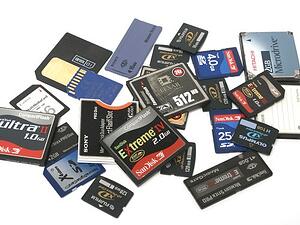 As we learned last month, there are several different factors to consider when purchasing a memory card. You need to know what type of card is compatible with your device, what size will best suit your needs and what speed range will work within the specifications of your device. My last blog entry about SD Cards focused mainly on storage size. We took a look at how each density translates to the number of photos, movies, and music you can store on your card. This month we’re going to focus on the different methods used to rate speeds for SD, microSD and CF cards.
As we learned last month, there are several different factors to consider when purchasing a memory card. You need to know what type of card is compatible with your device, what size will best suit your needs and what speed range will work within the specifications of your device. My last blog entry about SD Cards focused mainly on storage size. We took a look at how each density translates to the number of photos, movies, and music you can store on your card. This month we’re going to focus on the different methods used to rate speeds for SD, microSD and CF cards. SD Cards:
Secure digital (SD) cards are classified by an “x” speed rating for sizes up to 2GB. 4GB and higher (SDHC and SDXC) are rated using a “class” rating. According to SD Version 3.01 (PDF), SDHC cards are currently defined with Class 2, 4, 6, and 10, which translate to the following minimum speed requirements:| Class | Minimum Speed |
| Class 2 | 2 MB/s |
| Class 4 | 4 MB/s |
| Class 6 | 6 MB/s |
| Class 10 | 10 MB/s |
MicroSD Cards:
MicroSD cards are classified in a similar fashion as SD cards. 2GB and below are typically not labeled with a speed. This information is normally only listed in the specifications of the card. Because of this, speed is not normally an important factor for microSD cards with densities under 2GB. Cards with a size of 4GB and higher (microSDHC and microSDXC) are classified using the same “class” ratings as SD cards with similar capacities, including UHS.Compact Flash (CF) Cards:
Compact flash (CF) cards are classified using the same “x” rating used for SD and microSD cards with capacities of 2GB and below. Here's a list that outlines some of the most common speed ratings for CF cards:| 1000x = 150MB/s | 633x = 95MB/s | 266x = 40MB/s |
| 966x = 145MB/s | 600x = 90MB/s | 233x = 35MB/s |
| 933x = 140MB/s | 566x = 85MB/s | 200x = 30MB/s |
| 900x = 135MB/s | 533x = 80MB/s | 166x = 25MB/s |
| 866x = 130MB/s | 500x = 75MB/s | 150x = 22.5MB/s |
| 833x = 125MB/s | 466x = 70MB/s | 133x = 20MB/s |
| 800x = 120MB/s | 433x = 65MB/s | 100x = 15MB/s |
| 766x = 115MB/s | 400x = 60MB/s | 66x = 10MB/s (SD speed class 10) |
| 733x = 110MB/s | 366x = 55MB/s | 40x = 6MB/s (SD speed class 6) |
| 700x = 105MB/s | 333x = 50MB/s | 26x = 4MB/s (SD speed class 4) |
| 666x = 100MB/s | 300x = 45MB/s | 13x = 2MB/s (SD speed class 2) |
You can also refer to the formulas below to translate an “x” rating or a MB/s transfer speed: “x” transfer rate x 0.15MB/s = speed rating in MB/s speed rating in MB/s / 0.15MB/s = “x” transfer rate
The Importance of Transfer Speeds
With a plethora of manufacturers to choose from, it can be confusing to decide what memory card is best for your application. Transfer speeds can vary by manufacturer and/or card, and some manufacturers will classify their products by read speed while some will classify by write speed.
So why is speed so important? The demand for high speed audio and HD video is increasing and flash memory is the solution. Flash memory fills the need for both speed and quality and allows users to record data with minimal latency.











